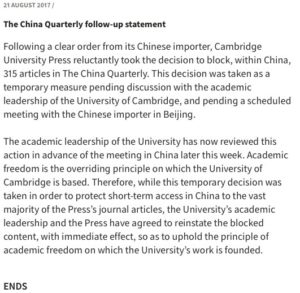Symposium on Occupation Law: The Writing the on the Wall 2.0: A Rejoinder
[Aeyal Gross is Professor of Law at the Tel-Aviv University Law School and Visiting Reader in Law at SOAS, University of London. In Fall 2017, he will be a Fernand Braudel Senior Fellow at the European University Institute. This post is the final post of the symposium on Professor Aeyal Gross’s book The Writing on the Wall: Rethinking the International Law of Occupation (CUP, 2017).]
Nothing could be more rewarding for authors than to have experts on the topics discussed in their books sharing ideas, concerns, and critiques. I am thus deeply grateful to the four contributors who devoted time and thought to comment on my book as well as to the editors of Opinio Juris. In this brief reply, I cannot do justice to all the contributors’ comments but will try to address some of them.
Eliav Lieblich addresses the normative/functional approach to occupation developed in my book and points to its potential for creating new ambiguities. Rather than limit the application of this approach to a “full” post-occupation stage, after states remove “boots on the ground” while retaining some form of control, Lieblich considers the option of states exercising control over some government functions in other states without a previous “traditional” occupation stage.
In a way, this question returns to a more fundamental one: should the beginning and end of occupation be viewed as symmetric for all purposes, including for a functional analysis of occupation? I address this question in my book and argue that dismantling an occupation is different from establishing one. One response to Lieblich, then, could be that the remnants of an occupation that never ended may possibly signal that the law of occupation continues to apply functionally, even when the remaining degree of control might have been insufficient to establish the occupation and apply the laws that govern it. Another answer, however, backed by some of the decisions of the Ethiopia Eritrea Claims Commission (EECC), support the notion that the law of occupation could be triggered based on partial or functional occupation and not only following a “full” occupation.
The question of what might be the triggering standards for functional occupation is also raised by Kristen Boon. Boon asks how to avoid a standard that is either too high (imposing positive obligations on states simply holding territories within their sphere of influence) or too low (permitting states to operate just short of the “boots on the ground” standard or taking advantage of new forms of technology while depriving individuals of the humanitarian protections they are legally owed). Finding a “one size fits all answer” may be hard, but one guiding principle should be whether the perceived occupier exercises some power over the territory with its actions preventing exercise of authority by other powers, especially the authorities of the occupied party. As I note in the book, Judge Kooijmans’s separate opinion in the Armed Activities (DRC v Uganda) case, which views states as occupiers when their actions preclude the functioning of local government, seems to be a step in the right direction (see pp. 74 and 129). Combined with the EECC approach mentioned above, we can consider that the responsibilities of occupation exist when power – not just influence – is exercised. From this perspective, continued Israeli control of the airways and waterways of Gaza in a way that does not allow the local population and its government to exercise control, seems like a clear case of occupation functionally continuing.
Whatever the answers we choose to Lieblich’s and Boon’s questions, they seemingly highlight two significant issues. The first is that, once we stop thinking of occupation in on/off terms, we realize that a continuum exists between occupation and other forms of control. The second is that, given occupation’s indeterminacy, the functional approach presented in my book attempts to replace a “pick and choose approach” with one that creates accountability, without claiming this to be a panacea to all the problems of the law of occupation. No such panaceas are available in law (or in life …).
Lieblich further ponders whether the functional approach does not ultimately collapse into some extra-territorial variation of human rights implementation. Although this is a valid question, it is pertinent to insist on the special protections that the law of occupation makes available (including the special status of protected persons) that are lost in a human rights analysis. In the last chapter of the book, I show how a human rights analysis often undermines the special protections accorded within the law of occupation. In this light, shifting the focus to the extra-territorial application of human rights law does not appear to be an alternative to the solution offered by the functional approach.
Finally, Lieblich mentions that the functional approach, which I began to develop in my work in 2007, has recently been endorsed by the ICRC. The need for this approach arose after the 2005 Gaza disengagement, growing out of both my academic research and my NGO work. I first presented it at the closing plenary lecture of a 2007 conference organized by the Minerva Centres for Human Rights at the Tel-Aviv and Hebrew Universities together with the ICRC, to mark the fortieth anniversary of the Israeli occupation of the Occupied Palestinian Territory, and first published about it in 2012, in a post that opened a symposium on the topic in this blog. As Lieblich notes, the ICRC adopted a variation of what was suggested in my work and the work of the Gisha NGO, on whose board I serve, and eventually backed the functional approach in its 2016 updated commentary on the Geneva Conventions, as documented here. The ICRC model, however, is a somewhat narrower version of the view developed in my book. It considers the functional approach relevant to “specific and exceptional cases,” whereas my analysis throughout the book shows that, given the indeterminacy of many situations where occupation and sovereignty are mixed, we need to rely on it regularly (see p. 133, n. 350). The Gaza situation and the analysis it required led me to a deeper understanding of how indeterminacy, control, and functions are always relevant to the understanding of occupation, be it in Berlin, Iraq, or Ethiopia-Eritrea.
While Lieblich’s comment considers the actual framework of the law of occupation, Valentina Azarova points to the connection between the law of occupation and other regimes of international law. Specifically, Azarova notes the role of jus ad bellum in the prohibition of annexation and shows how this prohibition should be seen as deriving from jus ad bellum rather than, as my analysis might imply, from the law of occupation itself. The law of occupation, she argues, depends for its proper function on the operation of other rules of international law, such as jus ad bellum, yet notes that an unlawful annexation maintained through occupation exposes the limit of the jus in bello/jus ad bellum distinction. Indeed, occupation highlights the complexities of the relationship between them, as Iris Canor noted. Azarova’s comments require me to reconsider the relationship between the law on the use of force (jus ad bellum) and occupation, a question I admittedly scarcely addressed in the book.
Going back to the law of occupation itself, Diana Buttu points to its limited role in giving any remedy to Palestinians. She argues that, despite very small legal victories (or, in her usage, “victories”), Israeli courts have legitimized Israel’s actions and prevented any scrutiny of the big picture, focusing instead on localized practices. Indeed, part of my reason for writing Illegal Occupation with Orna Ben-Naftali and Keren Michaeli in 2005 was to take back the discussion to the big picture— the illegality of the occupation itself. I find Buttu’s reservations about my statement that “only insisting on the normative content can save the benevolent reading of this body of international law… and prevent a return of colonialism” (252) intriguing, when she notes how, in the case of Israel, we are not facing a return of colonialism since it never left. Whereas I was alluding to the return of a colonialism that has been rendered illegal but might be brought back in the guise of a legally structured occupation, Buttu seems to be referring to this specific territorial context, pointing to the continuity of colonialism/occupation in Israel/Palestine (and beyond). How is this particular continuity an instance of a general continuity between the law of colonialism and the law of occupation? These questions need a broader scope than the one considered in my book. In his recent book on the Israeli occupation, Gershon Shafir touches on this relationship in the Israeli-Palestinian context from a historical political perspective, but further legal historical work seems warranted on this issue.
Coming from a very different perspective, and that is an understatement, Eugene Kontorovich questions the value of the normative approach from several perspectives, mainly that of gaps of enforcement in the law of occupation. Violations of the law of occupation by countries other than Israel have, in Kontorovich’s argument, gone unnoticed by the international community. But even if, for the sake of the argument, we agreed that Israel is treated as an exception, the enforcement gaps he addresses remain relevant to Israel too. He has counted about five hundred UN General Assembly resolutions dealing with Israel and very few regarding other occupations. These resolutions, however, remain unenforced and, moreover, since for the most they are not backed by the Security Council, are not even binding. How do these conditions affect Kontorovich’s suggestion that, before building a normative regime of occupation, it might make sense to bolster the existing one? I would argue that, without endorsing a normative approach, much of the criticism of Israel, at least at the legal level, not only lacks concrete enforcement but remains focused on specific issues, thus validating the bigger picture of this occupation rather than pointing to it as intrinsically illegal and illegitimate. The normative approach, then, which could help us to evade this vicious cycle, would prove vital for breaking the current impasse.
Kontorovich also notes that assigning a key role to self-determination, as I do in the normative analysis, constitutes a departure from current law and practice, which respect the sovereignty of states and not of peoples. Insistence on the relevance of self-determination first emerged in the 2005 Illegal Occupation article by Ben-Naftali, Michaeli, and myself. It is justified not only by the current understanding of self-determination in international law as a necessary interpretation of the law of occupation but also given the need to deal with occupation in areas where no state had previously been sovereign, such as the Occupied Palestinian Territory or Western Sahara. Taking self-determination out of this equation would imply denying protection to people who are occupied but had previously lacked a state.
Finally, though I do not share Kontorovich’s interpretation of the political context, I will avoid a factual and political argument on his determination that the Israeli occupation is different given the rejection of “numerous … good-faith offers of statehood to the Palestinians,” an issue I deliberately sidestepped in my book. My argument is that this occupation, which entails the constant dispossession of Palestinians, the establishment of a discriminatory apartheid-like regime, and illegal settlements whose existence is central to the dispossession and discrimination, is illegal regardless of who is to “blame” for the lack of an Israeli-Palestinian peace settlement. Had the occupation abided by international law (meaning no settlements and no dispossession of the Palestinian population) and notwithstanding the denial of liberties inherent in any situation of occupation, we would be engaging in an entirely different discussion. The current occupation, now ongoing for fifty years, which denies Palestinians their most basic liberties and dispossesses them daily, often denying their very life, must stop, and this illegal and inexcusably unjust situation must be brought to an end.


 Print This Page
Print This Page


